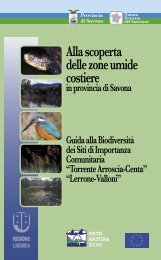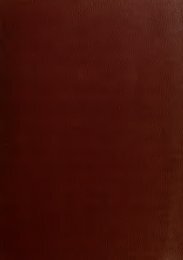Catalog of species-group names of Recent and fossil Scaphopoda ...
Catalog of species-group names of Recent and fossil Scaphopoda ...
Catalog of species-group names of Recent and fossil Scaphopoda ...
Create successful ePaper yourself
Turn your PDF publications into a flip-book with our unique Google optimized e-Paper software.
Species-<strong>group</strong> <strong>names</strong> <strong>of</strong> <strong>Scaphopoda</strong> (Mollusca)(1920: 108, 109) listed this <strong>species</strong> in his subgenusPlatyschides that was synonymized withGadila by Scarabino (1995). Although the placementinto Gadila is possible due to the inadequatelypreserved apical features, the stronglyoblique anterior aperture resembles that <strong>of</strong> severalPolyschides <strong>species</strong>.Cadulus (Platyschides) portoricensis Henderson,1920 has four apical lobes typical for the genusPolyschides. We, therefore, have transferred this<strong>species</strong> to Polyschides.Siphodentalium teres Jeffreys, 1883 has beenremoved from Siphonodentalium because it hasneither more than four apical lobes nor an anteriorconstriction, which is diagnostic <strong>of</strong>Siphonodentalium. Because <strong>of</strong> the long <strong>and</strong> slightlytapering shell <strong>and</strong> the radula morphology(polygonal, unicuspidate rhachis; lateral toothwith three cusps, the posterior two being closer toeach other <strong>and</strong> separated from the anterior cuspby a nodulous ridge), we have transferred this<strong>species</strong> to Pulsellum. The two lateral lobes atthe shell apex, however, are unique among the<strong>Scaphopoda</strong>.NEW SYNONYMIESThe following taxa have previously been recognizedas a valid <strong>species</strong>, or as infrasubspecific taxa,<strong>of</strong> Fissidentalium: Dentalium ergasticum Fischer,1883 (Pilsbry & Sharp 1897: 74, 75) <strong>and</strong> itsforms D. e. var. albida Locard, 1898, D. e. var.elongata Locard, 1898, D. e. var. major Locard,1896, D. e. var. minor Locard, 1898; D. milneedwardsiLocard, 1897; D. scamnatum Locard,1897 (Pilsbry & Sharp 1897: 79) <strong>and</strong> its formsD. s. var. alba Locard, 1898, D. s. var. minorLocard, 1898, D. s. var. subrecta Locard, 1898.However, these taxa fall within the range <strong>of</strong> variation<strong>of</strong> Fissidentalium capillosum (Jeffreys, 1877),as Bernard Métivier (MNHN; unpublished, pers.comm.) has demonstrated by his comparison <strong>of</strong>available type material <strong>and</strong> additional material.The synoymy <strong>of</strong> D. ergasticum Fischer, 1883,D. milneedwardsi Locard, 1897, <strong>and</strong> D. scamnatumLocard, 1897 with Fissidentalium capillosum(Jeffreys, 1877) is, therefore, credited toB. Métivier. Note that this synonymy changesthe name <strong>of</strong> the type <strong>species</strong> <strong>of</strong> the genusFissidentalium from Fissidentalium ergasticum toFissidentalium capillosum.Dentalium caudani Locard, 1896 <strong>and</strong> its formsD. c. var. parfaiti Locard, 1898, D. c. var. intermediaLocard, 1898, <strong>and</strong> D. c. var. minor Locard,1898 have previously been recognized as a valid<strong>species</strong>, or as infrasubspecific taxa, <strong>of</strong> Laevidentalium(Pilsbry & Sharp 1897: 104).However, these taxa fall within the range <strong>of</strong> variation<strong>of</strong> Fissidentalium c<strong>and</strong>idum (Jeffreys, 1877),as Bernard Métivier (MNHN; unpublished, pers.comm.) has demonstrated by his comparison <strong>of</strong>available type material <strong>and</strong> additional material.The synonymy <strong>of</strong> D. caudani Fischer, 1883 withF. c<strong>and</strong>idum (Jeffreys, 1877) is, therefore, creditedto B. Métivier.Dentalium exuberans Locard, 1897 <strong>and</strong> its formD. e. var. minor Locard, 1898 have previouslybeen recognized as a valid <strong>species</strong>, or as infrasubspecifictaxon, <strong>of</strong> Fissidentalium (Pilsbry & Sharp1897: 78, 79). However, shell shape <strong>and</strong> sculpture<strong>of</strong> these taxa are identical with the previouslydescribed F. paucicostatum (Watson, 1879), asBernard Métivier (MNHN; unpublished, pers.comm.) has demonstrated by his comparison <strong>of</strong>available type material <strong>and</strong> additional material.The synonymy <strong>of</strong> D. exuberans Locard, 1897with F. paucicostatum (Watson, 1879) is, therefore,credited to B. Métivier.Dentalium (Fustiaria) inversum Cossmann, 1915is placed in tentative synonymy with Fustiariamontense (Briart & Cornet, 1889) because it differsonly in the dorsal position <strong>of</strong> the apical slit.Cossmann (1915: 7) remarked that the type specimenmay be only an inverted specimen <strong>of</strong>Fustiaria montense. Dorsal displacement <strong>of</strong> the slitinfrequently occurs in other <strong>species</strong> <strong>of</strong> the genus(G. S. pers. obs.) <strong>and</strong> is, thus, not considered sufficientto separate a <strong>species</strong>, especially since thedescription was based on a single specimen only.Dentalium tessellatum Scarabino, 1995 matchesthe description <strong>and</strong> illustration <strong>of</strong> Dentaliumhabutae Kuroda & Kikuchi, 1933 in all details <strong>of</strong>shell shape <strong>and</strong> sculpture (V. Scarabino pers.comm., <strong>and</strong> in litt. 14.I.1997). Dentaliumhabutae is considered a valid <strong>species</strong> <strong>of</strong>ZOOSYSTEMA • 2004 • 26 (4)711




